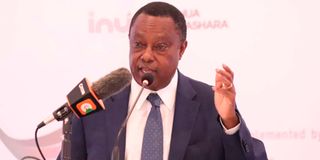Julius Muia: Why Treasury hides contracts it signs when borrowing money

National Treasury Principal Secretary Julius Muia. Muia directed all accounting officers in government ministries, departments and agencies to revise their budgets downwards in line with President William Ruto’s directive to shave off Sh300 billion from the current financial year’s budget.
This week, Dr Julius Muia, National Treasury Principal Secretary, answers your questions.
Why can’t the government make public contracts it signs with foreign entities when borrowing money? For instance, the SGR contract. Bashir Nuru, Nairobi
Contracts of this nature involve many other bilateral agreements as well other stakeholders across all nations and businesses. For this reason, it may not be possible to share all the information but basic binding principles are available for sharing with the public.
What is the Treasury doing to compel county governments to clear pending bills? Leonard Bwire, Mavoko
The government is committed to ensuring that at least 70 per cent of the equitable share and conditional grants are disbursed in the first nine months of the financial year so that counties are able to implement their budgeted plans on time. County governments are required to budget for any pending bills and submit a payment plan and a status of payment report to the Controller of Budget with a copy to the CS, National Treasury and Planning, for monitoring of implementation.
There is also a requirement by law that pending bills must be prioritised in the next budget and paid as first charge.
What are some of the achievements from the public finance management (PFM) reforms? Steve Kioko, Nairobi
PFM reforms are coordinated through the Public Financial Management Reforms Secretariat, under the National Treasury. Through this initiative, we have been able to develop a robust public sector procurement legal framework and gazettement of the Public Procurement Assets Disposal (PPAD) Regulations 2020 to fully operationalise the PPAD Act 2015. In addition, the Cabinet has approved the public procurement policy framework to provide a firm basis for future reforms.
A second reform was the operationalisation of the Kenya Institute of Supplies Examinations Board (KISEB). KISEB is expected to ensure that procurement professionals working in the public sector are well-certified and assessed.
A third reform is the development and the implementation of the Integrated Customs Management System (ICMS), which has helped to reduce the time taken to clear cargo from the Mombasa port of entry from 84 hours to 54.6 hours and we aim to achieve 50 hours.
In addition, the National Treasury has developed Public Investment Guidelines and an economic project appraisal manual to provide a clear guide on how projects in infrastructure and social sectors should be appraised.
This reform has further been advanced through the development of an automated appraisal system: Public Investment Management Information System (PIMIS). Once finalised, PIMIS will be used to identify and appraise projects for budgeting and also monitor the projects to completion. The public will also be able to access project information and be part of project monitoring.
Are there advantages in using public-private partnerships in funding projects? How can such projects be ring-fenced from abuse? Komen Moris, Eldoret
There are numerous advantages that accrue to citizens from Public-Private Partnerships. In theory and practice, PPPs are universally acknowledged as useful tools for mobilising private sector finance and harnessing private sector knowledge, skills, expertise, technology and innovation on projects that are for the public good.
In Kenya, every PPP project must subscribe to the principles enumerated under the PPP 2021 Act, that is, affordability, value for money and risk balance between government and the private sector. The PPP Act, 2021 has various in-built mechanisms to ensure value for money.
How can financial indiscipline in counties be addressed? Komen Moris, Eldoret
It is the responsibility of individual county assemblies and the Senate to oversight the counties. However, the National Treasury analyses the annual reports and intervenes appropriately in line with the law and its mandate.
Reports suggest that Kenya is borrowing Sh2.5 billion daily and using Sh2.4 billion to repay loans. Is this not a sign of how bad we are doing? Patrick W. Ndege, Kirinyaga
These allegations are unfounded and unsupported by evidence. The government’s borrowing decisions are communicated through approval by Parliament of the Budget Policy Statement, which contains the deficit for the next financial year. This approval effectively authorises the National Treasury to borrow. Further, such borrowing is guided by the medium-term debt management strategy, which ensures an optimal cost-risk combination of the resultant debt portfolio.
Sometimes, internal as well as external shocks to the economy may call for government interventions to restore the stability of economic units. Such interventions may be in the form of injection of funds to support projects or restore the economy to the state before the shock or increase in performance of the economy.
Please comment on the so-called budgeted corruption? Githuku Mungai, Nairobi
The term “budgeted corruption” can be restated simply as misappropriation of funds, which can only occur when people do not follow the laid down laws, processes and procedures.
The law is very clear on what needs to be done and when incidences of corruption arise, it is because the due process was not followed.
What is the government doing to support county governments to increase their own revenues to be self-sufficient? Belleh Otieno, Kisii
The National Treasury is providing technical support to counties to ensure optimisation of their own-source revenue. In this regard, a multiagency team developed the national policy to support enhancement of County Governments Own Source Revenue (OSR). The policy outlines a number of measures to be taken by both levels of government which include estimation of the OSR potential.





